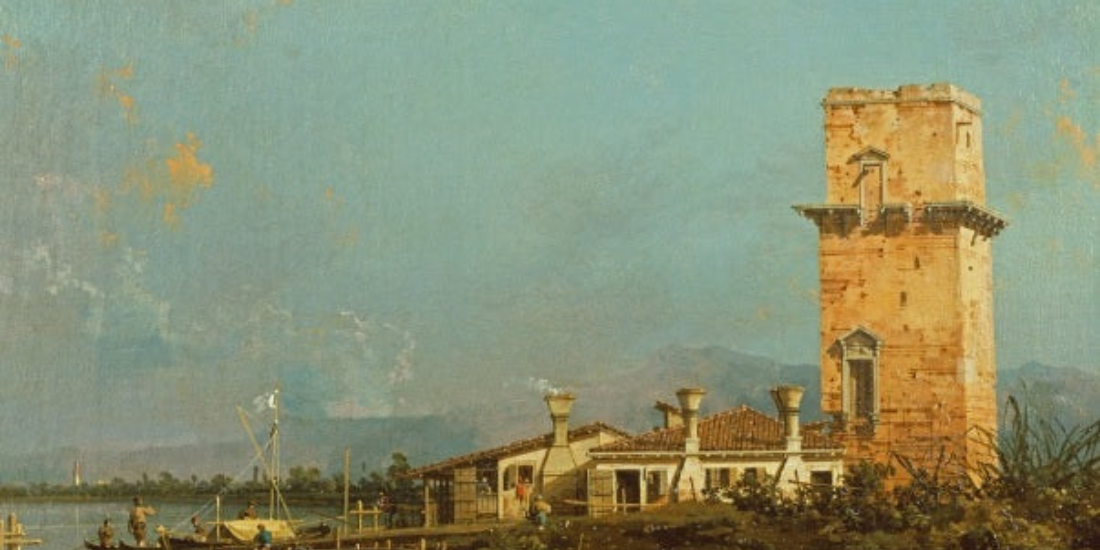
Canaletto's Marghera Tower, a memory of peripheral Venice
Jayde BrowneShare
The painting The Tower of Marghera by Canaletto, painted with the oil on canvas technique around 1741, presents a clear and perfectly balanced view of the Venetian lagoon, dominated by the presence of the ancient military tower of Marghera near Mestre. In the foreground the calm surface of the water extends, crossed by light boats with fishermen absorbed in their work; the shore is enlivened by other figures engaged in various activities or in motion.
On the right, the tower rises imposing and solid, with its ochre brick walls marked by vertical windows and hanging arches, beside simple rural buildings with red roofs and tall chimneys. The green of the vegetation counterbalances the architectural mass, and in the background the bluish mountains can be glimpsed closing the scene. The clear blue sky, streaked with a few golden clouds, embraces and enhances the scene’s diffused brightness. The viewpoint is slightly oblique to the shoreline: the composition allows the eye to take in both the watery and the terrestrial landscapes in depth, creating an airy dialogue between nature and architecture.
BUY A REPRODUCTION OF “THE TOWER OF MARGHERA” BY CANALETTO

Formal analysis
Oil painting allows Canaletto to orchestrate a symphony of transparent and vibrant colors: the sky stands out for its shades of Prussian blue and light azure, using gradations of white and gray that modulate atmospheric light through a “glazing” effect typical of the Venetian school.
The tower is rendered with touches of ochre, Venetian red, and warm browns, with precise brushstrokes that simulate the play of sunlight on surfaces. The buildings and foliage are enlivened with greens and yellows that reflect the vitality of the lagoon. Canaletto demonstrates an extraordinary ability to handle light: the high sun casts short, sharp shadows that highlight the architectural volumes and the transparency of the waters.
The human figures and boats are defined by quick yet effective touches that suggest movement without weighing down the composition. Balance is ensured by the dominant horizontality, countered by the tower’s verticality and the curved gestures of the shrubs. The visual rhythm is articulated through the arrangement of figures, the diagonals of the boats, and the modulation of colors that transform into accents of light and shadow across the entire canvas.
Iconographic analysis
The Tower of Marghera embodies the historical memory of the Venetian territory—a defensive presence that becomes both an identifying and symbolic element, especially since the building was already perceived in Canaletto’s time as a “relic” of history.
The boats with fishermen and the figures on the shore do not perform extraordinary actions but engage in ordinary tasks, emphasizing the industriousness of lagoon life. The objects in the scene—nets, oars, tools—interact with natural and architectural elements, narrating a rhythm governed by water, labor, and nature. There are no explicit mythological or religious references, but rather a sacralization of the landscape and of everyday life. The narrative function of the painting lies in its depiction of a marginal corner of Venice, far from the grand views and symbols of power.
Iconological analysis
Canaletto’s choice to focus on a peripheral subject, rendered with accuracy and dignity, reveals an Enlightenment sensibility aimed at valuing reality in its entirety—without hierarchies between monument and ordinary place. The Tower of Marghera, immortalized before its demolition in 1808, becomes a sign of fragility and transformation within the landscape, a reminder of the necessity to preserve memory through art.
In this work, one perceives a democratic vision of the city, where even uncelebrated places are worthy of being immortalized. The message is one of a diffuse and silent beauty—a Venice that hides in its details and in everyday lives.
Stylistic analysis and comparison
The painting belongs to the great tradition of Venetian vedutismo (view painting), from which Canaletto inherits a passion for perspective and optical precision, yet distinguishes himself through his painterly sensitivity and modern handling of light and color.
Compared to predecessors such as Carlevarijs or contemporaries like Bellotto and Guardi, this work stands out for its atmospheric transparency, the mobility of light, and its ability to render humble and marginal subjects as monumental. The choice of a view drawn from life, composed with absolute fidelity and animated by everyday activity, marks a move beyond celebratory vedutismo and an opening toward modern pictorialism. The innovation lies precisely in the optical realism and chromatic boldness that shape a scene suspended between document and poetry.
Critical evaluation and final synthesis
The Tower of Marghera stands out for its technical perfection, stylistic coherence, and expressive strength: every chromatic and luminous detail contributes to creating a balanced and harmonious image. The painting serves as testimony to art’s ability to preserve the memory of vanishing places. On both visual and conceptual levels, the canvas conveys a peripheral and authentic Venice, where monumentality coexists with ordinary simplicity—in a sublime synthesis between the real and the ideal.
By painting the Tower of Marghera, Canaletto invites the viewer to look beyond stereotypes and to discover the charm of small, overlooked things.
